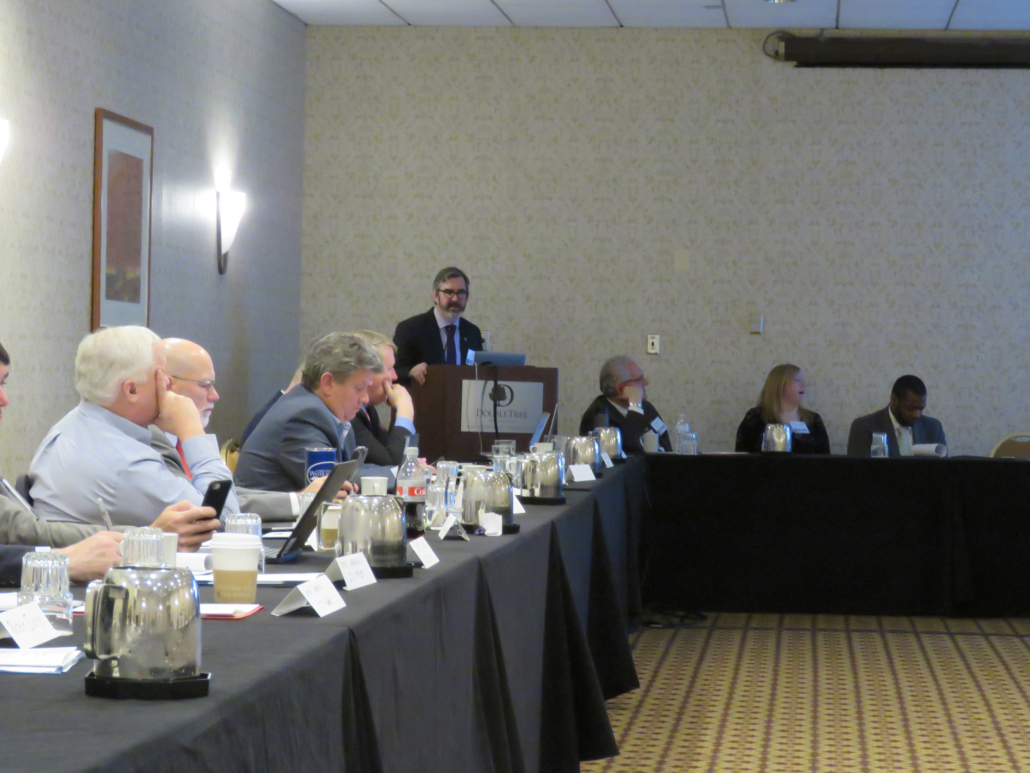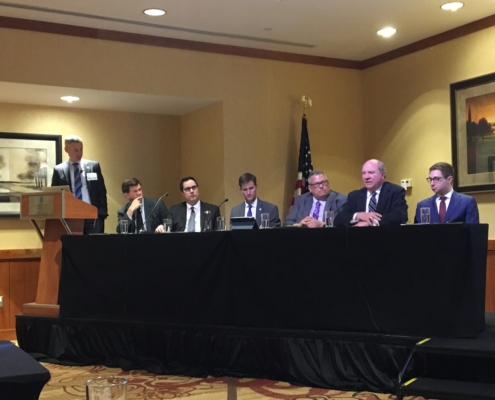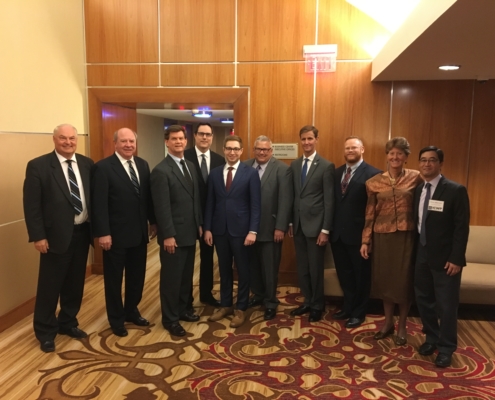Interstate Council on Water Policy 2019 Washington DC Roundtable Summary
April 2-4, 2019 | Crystal City Doubletree
Downloadable Presentations:
Revolutionize_USACE_CW2019
Aaron Snyder, Michael Tarpey, Lauren Leuck, Richard Darden, USACE Infrastructure Team
Dam_Safety_Tutka
Travis Tutka, USACE Safety of Dams
GWSIP_USGS_Wagner
Chad Wagner, USGS GWSIP
WAUSP_USGS_Dalton
Mindi Dalton, USGS WAUSP
NIDIS_Veva
Veva Deheza, National Integrated Drought Information System
Raleigh_Water_Supply_Belk
Chris Belk, Hazen and Sawyer
Partnership_Agreements_Wallace_Hague
Kirsten Wallace, UMRBA and Jimmy Hague, The Nature Conservancy
NWS_Water_Prediction_Graziano
Dr. Thomas Graziano, NWS Office of Water Prediction
USDA-NRCS_Watershed_Pgms_Farmer
Kevin Farmer, USDA-NRCS Watershed Programs
DoE_Grand_Challenge_Defontaine
Andre DeFontaine, Department of Energy
3DEP_Coalition_Byrd
John JB Byrd, 3DEP Coalition
Tuesday, April 2, 2019
The Interstate Council on Water Policy was pleased to co-host the 2019 Washington DC Roundtable with the National Water Supply Alliance.
Panel # 1. Revolutionize USACE Civil Works– Infrastructure Panel-USACE
Aaron Snyder discussed financing and budgeting reforms. Michael Tarpey updated on the Accelerate Project Delivery activities, including getting WRDA project guidance completed more quickly. Lauren Leuck, Strategic Communications—working on improving getting feedback from those needing permits and project sponsors. Webinars will be held in June, 2019. Richard Darden talked about the permitting programs within the USACE and how to improve turnaround time, eliminating redundancy in the permitting program and regulatory guidance. EO 13807—One Federal Decision. Aug. 2017. Two-year process to complete. Some HQ decisions have been moved to the district and divisions and the designating of a Lead District for projects that span boundaries. A more visible tracking system that the public can access is being developed a USACE is working on getting more information into that database. There is a goal of NOI to ROD 2 years. The team is trying to focus on a few priorities and do 5 or 6 topics well and get them done rather than a shotgun approach.
Panel # 2—Federal Agency Updates
Travis Tutka, USACE; Hazard creep—the increased building into downstream areas below dams presents challenges for Dam Safety Programs. FEMA is the dam safety regulation agency for the feds. ½ of USACE projects are high hazard. Dam Safety Action Classification (DSAC) 1-5 classified based on risk. Chad Wagner—overview of USGS GWSIP—Water Outlook, National Groundwater Network, Hazards Response (storm surge—hurricanes, tsunamis,) NAS Future Water Priorities for the Nation included recommendations to GWSIP. Chad went over some of the increased funding received in FY18 and 19, specifically for the Next Generation Water Observation System. Density of current gages covers 3/100ths of 1% of stream miles and predictive models are much improved. In the Delaware River Basin, funding from NGWOS was able to install 50 new gages to fill in both mainstem and smaller streams. Adding webcams to all streamgages. Mindi Dalton—USGS Water Availability and Use Science Programs. Integrated Water Availability Assessments–determining the demand side and its adequacy. WUDR Program Announcement is out now—closes May 31. IWAAs Pilots were described. Veva Deheza—NIDIS—Looking to integrate more of the USGS products into NIDIS delivery. 3rdReauthorization signed on Jan. 7 2019. Congress directed more relationship with private sector and taking a watershed approach. Develop soil moisture network for the US within the next year. National Drought Forum—July 30-31 more of a focus on business and economic impacts at this Forum than in 2012. Public health and drought summit this summer. Drought Trade impacts in Mississippi Basin.
Drew Dehoff, Executive Director of the Susquehanna River Basin Commission and current ICWP Interstate Water Management Committee Chair described a 2006 Interstates report that ICWP plans to update. The committee will look at the case studies to determine if still relevant. New laws have been passed since 2006 and how budgeting and financing might be different. Federal aspects of partnering and are there authorities for federal agencies to allow interstate entities to participate. Emily Vorek, an intern with the ICWP looked at the 15 organizations mentioned in the 2006 report. She first looked at those, then she looked into how many interstate organizations are in existence. She has also developed an outline for the Primer, envisioned to be a 4 page summary of how interstate river management organizations function.
Luncheon—Amber Levofsky-Federal Permitting Improvement Steering Council—filled in for Alex Herrgott—The main goal of the Steering Council is to streamline all permitting at the federal level. Layers of approval that are linear means that if one change gets made, can add significant time to getting the project approved.
Panel # 3. Water Planning and Policy Topics
Chris Belk -Hazen & Sawyer discussed the role of Falls Lake in Raleigh NC’s water supply. The City is interested in some operational changes at the reservoir and although much analysis had been done on Falls Lake over the years, once reallocation was determined to be the best alternative still took 5 years to get the project through Corps steps. Kirsten Wallace and Jimmy Hague—Non-federal cost share Project Partnership Agreements Three issues in Cost share agreements 1) Indemnification 2) OMRR&R (Operation Maintenance, Repair, Replacement and Rehabilitation,) and 3) Donated goods. NAPA Nonfederal sponsors shoulder an unfair share of liability risk—Sometimes they still sign as they feel no project is a greater risk. Academy said there was some legislative work around in one state (Kirsten thinks Wisconsin) TNC and UMRBA planning language for WRDA 2020 and appreciate any help to get this language reform included.
Panel # 4– Congressional panel

A token of ICWP’s appreciation for Julie Cunningham serving as Chair in 2018. (with Sue Lowry)
Jocelyn Buck Hunn, House Appropriations-House floor leader wants Budget bills down by June. $117M below FY19 enacted. Went through the big cuts in eh President’s budget for FY20. Camille Touton-House T & I-Fully utilize the Harbors Trust Fund. Hearing next week on Inland Waterway and Harbor Trust Fund. WRDA 2020 to start drafting this fall. Ian Bennitt—House T & I-Minority T & I one of the bright spots of non-partisan work. EPW have also said they would start early on WRDA. Earmarks—will individual projects be included? Infrastructure Package—wide variety of funding options. Lifting of non-Defense caps, but allocations to each Approps Sub-Committee have not occurred. Involvements of stakeholders in Implementation Guidance for USACE projects.
Wednesday, April 3
Morning Roundtable and Afternoon Federal Water Sub-Cabinet
Panel #5. Federal Agency Updates
Tom Graziano, NWS Office of Water Prediction–NWS Strategic Plan—4 Water area goals— “actionable” water resource predictions. Minutes to Months river flows. National Water Model—IWRSS discussion and plan led the agencies to understand they needed to work together even more closely. That plan led to the Water Center in 2015 official opening. NOAA, NWS, USGS all housed at the Water Center. Water Prediction Operations—want to staff with 12 -13 by end of this fiscal year. USGS, USACE, NWS, FEMA “Integrated Water Resources Science and Services”. NSF, CUAHSI, UCAR and NCAR—Academic research at the Water Center. John Bolten—NASA Applied Sciences Program- 19 satellites collecting data that have some water resources application. Snow cover and improving river forecasts. Drought early warning. OpenET. Kevin Farmer—Watershed Program Manager–NRCS. With resources through the PL566 Program, there are now over 11,840 dams in the US. Watershed Rehabilitation Program—extend the life of older NRCS funded projects. PL566 projects started getting built in 1948. 2000 of 11,840 are high risk. Emergency Watershed Protection Program to disasters such as Flood, Fire, Drought, Windstorms, Earthquakes. Reduce imminent threat to life or property. 60 days to apply after the disaster event. Andre DeFontaine—DOE— Energy-Water Nexus Activities led to the Water Security Grand Challenge. 5 Goals by 2030 A Grand Challenge offering a prize tries to get at the “unusual” suspects to get outside thinking. Prize proposals in late April.
Panel #6 Working with our Partner Water Organizations
Peter Colohan is the recently hired initial director for the Internet of Water housed at Duke University. He discussed the types of information and how the collaboration will seek out water data already available, but improve upon the delivery of those data. JB Byrd 3DEP Coalition. FEMA puts more $$ into the 3DEP program than does USGS. About 54% of US mapped in LIDAR. Requesting $146 M for FY20 for 3DEP. IMAGES legislation introduced into the current Congress. Tony Willardson, WSWCdescribed his Council’s relationship with WGA and supporting their positions. States are NOT stakeholders. WaDE got its start via the work with Sandia Labs and determining where water might be available for future energy production. WaDE funding from the foundations has helped keep separate from the need for raising state dues to support the Technical side. Kevin Werner-WESTFast Chair gave an overview of the goals for this afternoon’s event with the Water Sub-cabinet.
Thursday, April 4
ICWP and the NWSA met separately with the ICWP meeting at the Department of Interior with USGS Water Disciple management to discuss a number of water data and modeling issues. ICWP members then spend the rest of the day on Capitol Hill delivering the USGS Streamgaging Program support letter to the Interior Sub-Committee on Appropriations members, as well as with members of the Senate Environment and Public Works committee.
Conclusion: Many thanks to our sponsors: YSI-Xylem, Hazen and Sawyer, CDM-Smith, Burns and McDonnell, Barr Engineering, OTT-Hydromet, In-Situ, Freese and Nichols, and the Tarrant Regional Water District. We couldn’t do these meetings without your support!!
Please plan to join ICWP at their 2019 Annual Meeting on October 8-10, 2019 in Mobile, AL



